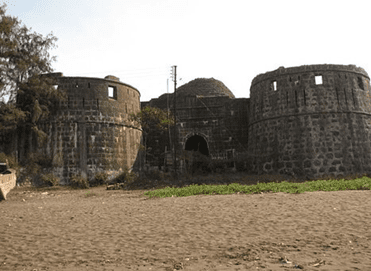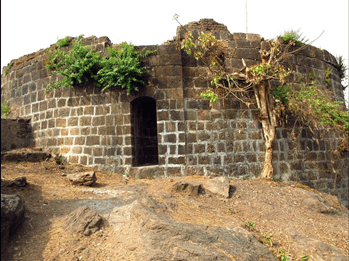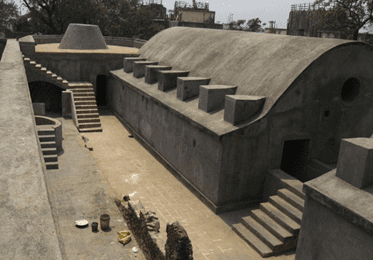Here are some amazing facts about the forts of Mumbai that mark the city’s glorious past.
Mumbai was once a group of several islands collectively called Bombay. From the Marathas to the Mughals, the British and even Portuguese reigned over it at different points in time.

Few know that Bombay was fortified to withstand enemy attacks and several forts were built for this purpose. Though quite a few of them have been ravaged by time, their marks still remain, having withstood the tests of weather over the decades.
Bassein Fort – lesser known forts of Mumbai
Built by the Portuguese in 1536 and spread over 110 acres, the Bassein Fort aka Vasai Fort is one of the best specimens of Indo-European defensive architecture.
This giant fort had three convents, six churches, and one cathedral in addition to numerous public and private buildings including the original St. Sebastian Fort, Misericordia, senate house, town hall, factory, hospital, college, library, coin mint, and a buzzing marketplace. This commercial, political and military base of the Portuguese for nearly 300 years, was home to 2400 soldiers, 300 residents, nobles, and artisans.

In 1739, the Marathas, under the leadership of Chimaji Appa, the younger brother of Peshwa Bajirao I, took control of the fort and placed many victory symbols on the premises, including a temple and a statue. In 1802, the British took away the territory from the Marathas after the Treaty of Bassein.
Interestingly, the court door of the Bassein Fort is still preserved carefully at the Remedy Church in Vasai. Though large parts of this historic fort-city have fallen to ruin, several watchtowers, with safe staircases leading up, still stand. The fort is a popular shooting location for Bollywood films and songs.
It is a Nationally Protected Monuments under the Archaeological Survey of India.
Sion Fort – lesser known forts of Mumbai

Built on a hillock by the British under the East India Company between 1669 and 1677, the Sion Fort marked the boundary between the Parel Island held by them and the Portuguese-controlled Salsette Island, north across the creek.
Offering a panoramic view of the eastern coast, the Sion Fort has a series of beautiful pathways, a couple of ruined rooms, and an old cannon at the top. At the base, is a garden named after Pt. Jawaharlal Nehru. From one side of the fort, one can enjoy a striking view of the distant salt pans in Thane Creek.
Restoration of the Sion Fort, which was notified as a Grade I Heritage Structure, had begun in 2009 but was stopped due to a paucity of funds.
Belapur Fort – lesser known forts of Mumbai

The Belapur Fort was built by the Siddis of Janjira in 1560-1570 after they wrested control of the area from the Portuguese. Located atop a hillock near the mouth of the Panvel Creek, it was recaptured by the Portuguese in 1682, after they annexed the nearby regions controlled by the Siddis.
In 1737, it came under the control of the Marathas, led by Chimaji Appa, who vowed that if they’d successfully captured the fort from the Portuguese, he would place a garland of beli leaves in the nearby Amruthaishwar temple. Post the Marathas’ victory, it was renamed, Belapur Fort. In June 1817, the British East India Company army captured and partially destroyed it under the policy of razing any Maratha stronghold in the region.
A tunnel is also said to exist in the fort, which several locals believe connects the fort to Gharapuri Island, where Elephanta Caves are located.
Sadly, not much has been done for the restoration of this once strategic fort. It is an unprotected monument, at present with C.I.D.C.O.
Arnala Fort -lesser known forts of Mumbai

Strategically located at the mouth of the Vaitarna river, the Arnala Fort was built in 1516 by a local chieftain of Gujarat, Sultan Mahmud Begda. It is the specimen of the Maratha and regional defense architecture. In the 1530s, the Portuguese established their operations in the coastal area, with their headquarters at the Bassein Fort, and soon gained control of the island.
During the late 17th and early 18th centuries, the Maratha Confederacy came to dominate the region. After capturing the Bassein Fort from the Portuguese, whom he attacked at the behest of his elder brother, Peshwa Bajirao I, Chimaji Appa set his sights on Fort Arnala, as it would strategically help the Maratha navy in attacking Portuguese interests.
A plaque, installed by the Marathas on the northern wall of the fort, to commemorate their victory, in March 1737, is still visible today. This fort is rectangular in shape and has many temples such as Tryambakeshwar, Bhavani Mata, Kalika Mata, and also of Mahadev. The doorway of the fort is beautifully decorated with pictures of elephants and tigers.
It is a Nationally Protected Monument under the Archaeological Survey of India.
Ghodbunder Fort – lesser known forts of Mumbai

Located in the Ghodbunder village, on the hilltop by the Ulhas River, in Mira Road, this fort was initially named Cache de Tanna by the Portuguese, who built it in 1550, in European architectural form, from stone blocks. Of the two churches built then, one is in good condition even today.
The place also came to be called Ghodbunder as the Portuguese used to trade horses here with the Arabs. This fort came under the Maratha Empire only after Chimaji Appa defeated the Portugal forces. In 1818, the British East India Company took over the fort from the Marathas and made it its local administrative office. It has a great rampart with many bastions alongside its walls and also watchtowers on the top.
Recently, the Archaeological Survey of India (ASI) Ratnagiri and the Directorate of Archaeology and Museums, Mumbai have decided to start restoration work on the fort.
Riwa Fort – lesser known forts of Mumbai

Locally known as the Kala Qilla or Black Fort, the Riwa Fort is located in Dharavi, on the banks of the Mithi River. The most significant part of this Into-British architecture is that its main ramparts are built with laterite stones found in black colours.
Part of the larger Bombay Castle, this fort also marked the northern portion of the British-held Bombay in the 17th century. The then Governor John Horne commissioned the construction of the Riwa fort, in the shape of a boomerang, to protect Bombay from the aggressive sea-faring Maratha leader Kanhoji Angre.
Interestingly, the Riwa Fort also has an underground tunnel, which was built for an unobstructed flow of the Mithi River in those times. It is a State Protected Fort under the Directorate of Archaeology and Museums (Government of Maharashtra).
Sewri Fort –lesser known forts of Mumbai

Built on the island of Parel in 1680, The Sewri Fort was one of the fortifications constructed by the British to ward off enemy attacks on their territory.
In 1689, the Siddi General Yadi Sakat invaded Bombay with an army of 20000 men and first captured the Sewri Fort. The Fort in 1772 also witnessed another battle that repelled a Portuguese attack. Post the decline of the regional powers, it was used to house prisoners.
Currently owned by the State’s Department of Archaeology and Museums, Maharashtra Govt, and classified as a Grade I heritage structure, efforts are underway under Phase I of the Mumbai Fort Circuit Project to restore it. The strategic location of the Sewri Fort is said to promote ornithology as the area overlooks the mudflats that are frequented by migratory birds, particularly the lesser flamingos.
Speaking about these forts, Dr. Mayur Thakare, Assistant Archaeologist, Directorate of Archaeology and Museums, Govt. of Maharashtra, said, “These forts are not just the dead monuments of the bygone era, but are the living links which connect the present grand Mumbai Metropolitan Region to its humble origin in the past. They stood rock solid to protect Mumbai or Bombay in their prime days and are aging gracefully now. They are a unique testament to our multicultural society and History.”
He added, “These forts have a wide scope of research, conservation, and restoration activities. They need to be thematically and carefully conserved not just to protect their existence but to showcase their structural and site development over the years and centuries. They are as lively as we are. Only we need to tune with them respectfully in this era of urbanism and not thrust our short-sighted urban requirements over them. We must ensure to pass this heritage to our future generations.”
Mumbai has a diverse culture and a long and rich history. Though some of the forts in the city are in dilapidated condition, they are considered to be magnificent works of architecture and narrate the glorious past of Mumbai.
Read More: Discover your India



